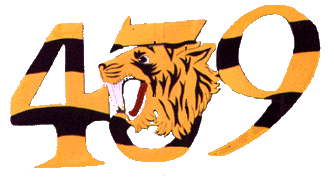Low cloud washed out this operation, however, and as an alternative the pilots went out in two formations of four
and eight to drop their new missiles on any "targets of
opportunity". The larger group, led by the C.O., found the sky clear over Udem (east of
Goch) and let their cluster bombs go at 4000 feet. So many explosions erupted in and around the town that
"it looked like a
heavy bomber raid in miniature".
Udem was notorious as a hot flak
area, and Vic Le Gear's aircraft received some damage from one burst. The smaller group led by Johnny Carr had gone farther east
to drop their bombs through cloud breaks over Dingden (south of
Bocholt); the results seemed to be "very
good". The four pilots then stooged around looking for more targets and near Haltern they found two goods (freight) trains. Both engines were soon hissing steam
"where steam shouldn't
pour", and ten of the cars were also
damaged. Homeward bound the section passed over the Udem hot spot and received a
"potful" from the 88 mm. guns. A close one smashed five holes in the wing of Al McBride's Typhoon.
|
Intentionally
left blank
|
Intentionally
left blank
|
Then the rain came down again and the pilots' crew room was soon almost surrounded by water. Inside it, however, life was quite comfortable and the pilots, by now reconciled to
"Dutch weather", discussed how they could convert the building to a houseboat, if need be. They estimated that the big stove was capable of producing enough steam to give a maximum speed of five knots with a tail wind.
At noon on 10 February the rain subsided and for 24 hours the sky remained almost cloudless. In that period six operations were carried out, three on the l0th and three on the 11th. Two rails were cut, a house was destroyed, and a canal and bridge were damaged.
WO Dick Roach, a new pilot, was the house wrecker. With three companions he had gone down in a steep dive through a hole in the clouds to bomb the rail line between Coesfeld and
Dulmen. The 1000 lb.ers did not cut the tracks, but Dick saw his pair demolish a house and set the ruins on fire. The rail cuts were made in the Winterswijk Borken line by two sections led by Lyal Shaver and Jim Beatty. Lyal returned from his outing with several flak punctures in the aircraft. Both attacks were made through breaks in the clouds; two other formations, however, were unable to find any openings at all over the tactical area and had to jettison their bombs live over
Hunland.
|
|
On the last sortie of this period S/L Beatty's section after a long hunt over the clouds looking for a target of
opportunity found a small hole through which a canal and road bridge could be seen.
Attacking in a shallow dive, the quartet achieved a "beautiful piece of grouping" with the eight bombs straddling the canal, caving in
its bank and covering the bridge with debris.
WO Bud Propas was seriously injured on 10 February when his engine cut while he was making an airframe and engine test. The aircraft burst into flames as he crashlanded at B.86 Helmond and Bud received a fractured skull and facial burns before he was pulled from the wreckage. He had 13 sorties to his credit. Two new pilots had joined the squadron early in February, WO2
R.J. Roach and F/L S.C. Jackson. The latter was an American who had completed one tour with an R.A.F. squadron in India.
  
Copyright
©1998-2016 Michael T. Melnick. All rights reserved
the
unofficial homepage of  Tiger
Squadron Tiger
Squadron
.
.
|